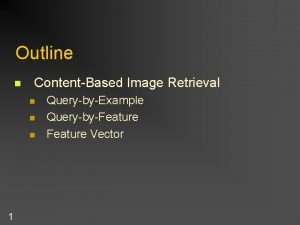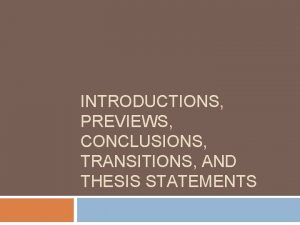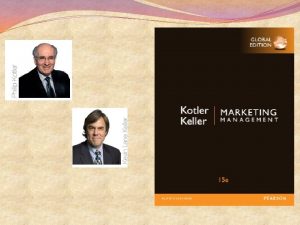Instructor Morteza Maleki Ph D 1 Preview Research






























































- Slides: 62

Instructor Morteza Maleki, Ph. D 1


Preview ü Research designs are plans and the procedures for research that span the decisions from broad assumptions to detailed methods of data collection and analysis. ü It involves several decisions and they need not be taken in the order in which they make sense to the researchers. 3

Three Types of Designs I. Qualitative Method, II. Quantitative Method, and III. Mixed Methods ü Qualitative and quantitative approaches should not be viewed as polar opposites or dichotomies; ü Instead, they represent different ends on a continuum (Newman & Benz, 1998). ü A study tends to be more qualitative than quantitative or vice versa. ü Mixed methods research resides in the middle of this continuum because it incorporates elements of both qualitative and quantitative approaches. 4

Three Types of Designs ü Often the distinction between qualitative and quantitative research is framed in terms of 1) 2) Using words (qualitative) rather than numbers (quantitative), Using closed-ended questions (quantitative hypotheses) rather than open-ended questions (qualitative interview questions). ü A more complete way to view the gradations of differences between them is in 1) The basic philosophical assumptions researchers bring to the study, 2) The types of research strategies used overall in the research (e. g. , quantitative experiments or qualitative case studies), and 3) The specific methods employed in conducting these strategies (e. g. , collecting data quantitatively on instruments versus collecting qualitative data through observing a setting). 5

Three Types of Designs ü Qualitative research is a means for exploring and understanding the meaning individuals or groups ascribe to a social or human problem. ü The process of research involves emerging questions and procedures, ü Data typically collected in the participant's setting, ü Data analysis inductively building from particulars to general themes, ü The researcher making interpretations of the meaning of the data, and ü The final written report has a flexible structure. ü Those who engage in this form of inquiry support a way of looking at research that honors an inductive style, a focus on individual meaning, and the importance of rendering the complexity of a situation 6

Three Types of Designs ü Quantitative research is a means for testing objective theories by examining the relationship among variables. ü These variables, in turn, can be measured, typically on instruments, so that numbered data can be analyzed using statistical procedures. ü The final written report has a set structure consisting of introduction, literature and theory, methods, results, and discussion (Creswell, 2008). ü Those who engage in this form of inquiry have assumptions about testing theories deductively. ü Building in protections against bias, ü Controlling for alternative explanations, and ü Being able to generalize and replicate the findings. 7

Three Types of Designs ü Mixed methods research is an approach to inquiry that combines or associates both qualitative and quantitative forms. ü It involves philosophical assumptions, the use of qualitative and quantitative approaches, and the mixing of both approaches in a study. ü It is more than simply collecting and analyzing both kinds of data; ü It involves the use of both approaches in tandem so that the overall strength of a study is greater than either qualitative or quantitative research (Creswell & Plano Clark. 2007). 8

Three Components involved in a Design ü Two important components in each definition are: I. II. Philosophical assumptions Distinct methods or procedures ü Research design (plan or proposal to conduct research) involves the intersection of philosophy, strategies of inquiry, and specific methods. ü In planning a study, researchers need To think through the philosophical worldview assumptions that they bring to the study, II. The strategy of inquiry that is related to this world view, and III. The specific methods or procedures of research that translate the approach into practice. I. 9

10

Three Components involved in a Design I. Philosophical World view ü In writing about worldviews, a proposal might include a section that addresses the following: 1) 2) 3) The philosophical world view proposed in the study A definition of basic considerations of that worldview How the worldview shaped their approach to research ü Worldview is "a basic set of beliefs that guide action" (Guba, 1990, p. 17). ü Others have called them paradigms (Lincoln & Guba, 2000; Mertens, 1998); epistemologies and ontologies (Crotty, 1998), or broadly conceived research methodologies (Neuman, 2000). 11

Three Components involved in a Design ü Worldviews is a general orientation about the world and the nature of research that a researcher holds; these world views are shaped by The discipline area of the student, The beliefs of advisers and faculty in a student's area, and Past research experiences. I. III. ü Four different worldviews are discussed: I. III. IV. Postpositivism, Constructivism, Advocacy/Participatory, and Pragmatism. 12

Three Components involved in a Design 13

Three Components involved in a Design I. The Postpositivist Woddview ü Postpositivists hold a deterministic philosophy in which causes probably determine effects or outcomes. ü The problems studied by Postpositivists reflect the need to identify and assess the causes that influence outcomes, such as found in experiments. ü It is also reductionistic in that the intent is to reduce the ideas into a small, discrete set of ideas to test, such as the variables that comprise hypotheses and research questions: ü The knowledge that develops through a postpositivist lens is based on careful observation and measurement of the objective reality that exists "out there" in the world. 14

Three Components involved in a Design ü Developing numeric measures of observations and studying the behavior of individuals becomes paramount for a postpositivist. ü There are laws or theories that govern the world, and these need to be tested or verified and refined so that we can understand the world. ü In the scientific method, the accepted approach to research by postivists, an individual 1) 2) 3) Begins with a theory. Collects data that either supports or refutes theory, and then Makes necessary revisions before additional tests are made. 15

Three Components involved in a Design According to Phillips and Burbules (2000), the key assumptions of this position include: 1) Knowledge is conjectural (and antifoundational) - absolute truth can never be found. ü Evidence established in research is always imperfect and fallible. ü It is for this reason that researchers state that they do not prove a hypothesis; instead, they indicate a failure to reject the hypothesis. Research is the process of making claims and then refining or abandoning some of them for other claims more strongly warranted. 2) ü Most quantitative research, for example, starts with the test of a theory. 16

Three Components involved in a Design Data, evidence, and rational considerations shape knowledge. 3) ü In practice, the researcher collects information on instruments based on measures completed by the participants or by observations recorded by the researcher. Research seeks to develop relevant, true statements, ones that can serve to explain the situation of concern or that describe the causal relationships of interest. 4) ü In quantitative studies, researchers advance the relationship among variables and pose this in terms of questions or hypotheses. Being objective is an essential aspect of competent inquiry; researchers must examine methods and conclusions for bias. 5) ü For example, standard of validity and reliability are important in quantitative research. 17

Three Components involved in a Design II. The Social Constructivist Worldview ü Social constructivists hold assumptions that individuals seek understanding of the world in which they live and work. ü Individuals develop subjective meanings of their experiences - meanings directed toward certain objects or things. ü These meanings are varied and multiple, leading the researcher to look for the complexity of views rather than narrowing meanings into a few categories or ideas. ü The goal of the research is to rely as much as possible on the participants' views of the situation being studied. 18

Three Components involved in a Design ü The questions become broad and general so that the participants can construct the meaning of a situation, typically forged in discussions or interactions with other persons. ü The more open-ended the questioning, the better, as the researcher listens carefully to what people say or do in their life settings. ü Often these subjective meanings are negotiated socially and historically. ü They are not simply imprinted on individuals but are formed through interaction with others (hence social constructivism) and through historical and cultural norms that operate in individuals' lives. 19

Three Components involved in a Design ü Constructivist researchers often address the processes of interaction among individuals. ü They also focus on the specific contexts in which people live and work, in order to understand the historical and cultural settings of the participants. ü Researchers recognize that their own backgrounds shape their interpretation, and they position themselves in the research to acknowledge how their interpretation flows from their personal, cultural, and historical experiences. ü The researcher's intent is to make sense of (or interpret) the meanings others have about the world. ü Rather than starting with a theory (as in postpositivism), inquirers generate or inductively develop a theory or pattern of meaning. 20

Three Components involved in a Design Assumption found by Crotty (1998) about Social constructivism: Meanings are constructed by human beings as they engage with the world they are interpreting. 1) ü Qualitative researchers tend to use open-ended questions so that the participants can share their views. The basic generation of meaning is always social, arising in and out of interaction with a human community. 2) ü The process of qualitative research is largely inductive, with the inquirer generating meaning from the data collected in the field. 21

Three Components involved in a Design Humans engage with their world and make sense of it based on their historical and social perspectives - we are all born into a world of meaning bestowed upon us by our culture. 3) ü ü Qualitative researchers seek to understand the context or setting of the participants through visiting this context and gathering information personally. They also interpret what they find, an interpretation shaped by the researcher's own experiences and background. 22

Three Components involved in a Design III. The Advocacy and Participatory Worldview ü It holds that research inquiry needs to be intertwined with politics and a political agenda. ü ü The research contains an action agenda for reform that may change the lives of the participants, the institutions in which individuals work or live, and the researcher's life. Specific issues need to be addressed that speak to important social issues of the day, issues such as empowerment, inequality, oppression, domination, suppression, and alienation. ü The researcher often begins with one of these issues as the focal point of the study. 23

Three Components involved in a Design ü This research also assumes that the inquirer will proceed collaboratively so as to not further marginalize the participants as a result of the inquiry; in this sense, the participants may help ü ü Design questions, Collect data, Analyze information, or Reap the rewards of the research. ü Advocacy research provides a voice for these participants, raising their consciousness or advancing an agenda for change to improve their lives. ü It becomes a united voice for reform and change. 24

Three Components involved in a Design Kemmis and Wilkinson’s (1998) key features of the advocacy or participatory forms of inquiry: Participatory action is recursive or dialectical and focused on bringing about change in practices. 1. ü Thus, at the end of advocacy/participatory studies, researchers advance an action agenda for change. This form of inquiry is focused on helping individuals free themselves from constraints found in the media, in language, in work procedures, and in the relationships of power in educational settings. 2. ü Advocacy/participatory studies often begin with an important issue or stance about the problems in society, such as the need for empowerment. 25

Three Components involved in a Design It is emancipatory in that it helps unshackle people from the constraints of irrational and unjust structures that limit self-development and selfdetermination. 3. ü The advocacy /participatory studies aim to create a political debate and discussion so that change will occur. It is practical and collaborative because it is inquiry completed with others rather than on or to others. 4. ü In this spirit, advocacy/participatory authors engage the participants as active collaborators in their inquiries. 26

Three Components involved in a Design IV. The Pragmatic Worldview ü Pragmatism is a worldview arises out of actions, situations, and consequences rather than antecedent conditions (as in postpositivism). ü There is a concern with applications-what works-and solutions to problems (Patton. 1990). ü Instead of focusing on methods, researchers emphasize the research problem and use all approaches available to understand the problem (Rossman & Wilson, 1985). ü As a philosophical underpinning for mixed methods studies, Tashakkori and Teddlie (1998), Morgan (2007), and Patton (1990) convey its importance for focusing attention on the research problem in social science research and then using pluralistic approaches to derive knowledge about the problem. 27

Three Components involved in a Design ü Key features of pragmatism approach according to Cherryholmes (1992), Morgan (2007): Pragmatism is not committed to any one system of philosophy and reality. 1) ü This applies to mixed methods research in that inquirers draw liberally from both quantitative and qualitative assumptions when they engage in their research. Individual researchers have a freedom of choice. 2) ü In this way, researchers are free to choose the methods, techniques, and procedures of research that best meet their needs and purposes. Pragmatists do not see the world as an absolute unity. 3) ü Mixed methods researchers look to many approaches for collecting and analyzing data rather than subscribing to only one way (e. g. Quantitative or Qualitative). 28

Three Components involved in a Design Truth is what works at the time. 4) ü ü It is not based in a duality between reality independent of the mind or within the mind. In mixed methods research, investigators use both quantitative and qualitative data because they work to provide the best understanding of a research problem. Pragmatists agree that research always occurs in social, historical, political, and other contexts. 5) ü Mixed methods studies may include a postmodern turn - a theoretical lens that is reflective of social justice and political aims. 29

Three Components involved in a Design Pragmatists have believed in an external world independent of the mind as well as that lodged in the mind. 6) ü ü 7) But they believe that we need to stop asking questions about reality and the laws of nature (Cherryholmes, 1992). "They would simply like to change the subject" (Rorty, 1983, p. xiv). For the mixed methods researcher, pragmatism opens the door to multiple methods, different worldviews, and different assumptions, as well as different forms of data collection and analysis. 30

Three Components involved in a Design II. Strategies of Inquiry ü The researcher not only selects a qualitative, quantitative, or mixed methods study to conduct, the inquirer also decides on a type of study within these three choices. ü Strategies of inquiry are types of qualitative, quantitative, and mixed methods designs or models that provide specific direction for procedures in a research design. ü Others have called them approaches to inquiry (Creswell, 2007) or research methodologies (Mertens, 1998). 31

Three Components involved in a Design 32

Three Components involved in a Design I. Quantitative Strategies ü During the late 19 th and throughout the 20 th century, strategies of inquiry associated with quantitative research were those that invoked the postpositivist worldview. ü These include true experiments and the less rigorous experiments called quasiexperiments and correlational studies (Campbell & Stanley, 1963) and specific single-subject experiments (Cooper, Heron, & Heward, 1987; Neuman & Mc. Cormick, 1995). ü More recently, quantitative strategies have involved complex experiments with many variables and treatments (e. g. factorial designs and repeated measure designs). ü They have also included elaborate structural equation models that incorporate causal paths and the identification of the collective strength of multiple variables. 33

Three Components involved in a Design 1) Survey research provides a quantitative or numeric description of trends, attitudes, or opinions of a population by studying a sample of that population. ü It includes cross-sectional and longitudinal studies using questionnaires or structured interviews for data collection, with the intent of generalizing from a sample to a population (Babbie, 1990). 2) Experimental research seeks to determine if a specific treatment influences an outcome. This impact is assessed by providing a specific treatment to one group and withholding it from another and then determining how both groups scored on an outcome. ü Experiments include true experiments, with the random assignment of subjects to treatment conditions, and quasi-experiments that use nonrandomized designs ü (Keppel. 1991). ü Included within quasi-experiments are single-subject designs. 34

Three Components involved in a Design II. Qualitative Strategies Ethnography is a strategy of inquiry in which the researcher studies an intact cultural group in a natural setting over a prolonged period of time by collecting, primarily, observational and interview data (Creswell, 2007 b). 1) ü The research process is flexible and typically evolves contextually in response to the lived realities encountered in the field setting (Le. Compte & Schensul, 1999). Case studies are a strategy of inquiry in which the researcher explores in depth a program, event, activity, process, or one or more individuals. 2) ü Cases are bounded by time and activity, and researchers collect detailed information using a variety of data collection procedures over a sustained period of time (Slake, 1995). 35

Three Components involved in a Design Grounded Theory is a strategy of inquiry in which the researcher derives a general, abstract theory of a process, action, or interaction grounded in the views of participants. 3) ü This process involves using multiple stages of data collection and the refinement and interrelationship or categories of information (Channaz, 2006: Strauss and Corbin. 1990, 1998). ü Two primary characteristics of this design are 1. The constant comparison of data with emerging categories and 2. Theoretical sampling of different groups to maximize the similarities and the differences of information. 36

Three Components involved in a Design Phenomenological Research is a strategy of inquiry in which the researcher identifies the essence of human experiences about a phenomenon as described by participants. 4) ü ü ü Understanding the lived experiences marks phenomenology as a philosophy as well as a method. The procedure involves studying a small number of subjects through extensive and prolonged engagement to develop patterns and relationships of meaning (Moustakas, J 994). In this process, the researcher brackets or sets aside his or her own experiences in order to understand those of the participants in the study (Nieswiadomy, 1993). 37

Three Components involved in a Design Narrative Research is a strategy of inquiry in which the researcher studies the lives of individuals and asks one or more individuals to provide stories about their lives. 5) ü ü This information is then often retold or restoried by the researcher into a narrative chronology. In the end, the narrative combines views from the participant's life with those of the researcher's life in a collaborative narrative (Clandinin & Connelly, 2000). 38

Three Components involved in a Design III. Mixed Methods Strategies ü Recognizing that all methods have limitations, researchers felt that biases inherent in any single method could neutralize or cancel the biases of other methods. ü Triangulating data sources - a means for seeking convergence across qualitative and quantitative methods-was born (Jick, 1979). ü By the early 1990 s, the idea of mixing moved from seeking convergence to actually integrating or connecting the quantitative and qualitative data. ü For example, the results from one method can help identify participants to study or questions to ask for the other method (Tashakkori & Teddlie, 1998). 39

Three Components involved in a Design ü The qualitative and quantitative data can be merged into one large database or the results used side by side to reinforce each other (e. g. , qualitative quotes support statistical results; Creswell & Plano Clark, 2007). ü Or the methods can serve a larger, transformative purpose to advocate for marginalized groups, such as women, ethnic/racial minorities, people with disabilities, and those who are poor (Mertens, 2003). 1) 2) 3) Sequential Mixed Methods Concurrent Mixed Methods Transformative Mixed Methods 40

Three Components involved in a Design Sequential Mixed Methods procedures are those in which the researcher seeks to elaborate on or expand on the findings of one method with another method. ü This may involve beginning with a qualitative interview for exploratory purposes and following up with a quantitative, survey method with a large sample so that the researcher can generalize results to a population. ü The study may begin with a quantitative method in which a theory or concept is tested, followed by a qualitative method involving detailed exploration with a few cases or individuals. 41

Three Components involved in a Design Concurrent Mixed Methods procedures are those in which the researcher converges or merges quantitative and qualitative data in order to provide a comprehensive analysis of the research problem. ü In this design, the investigator collects both forms of data at the same time and then integrates the information in the interpretation of the overall results. ü The researcher may embed one smaller form of data within another larger data collection in order to analyze different types of questions (the qualitative addresses the process while the quantitative, the outcomes). 42

Three Components involved in a Design ü Transformative Mixed Methods procedures are those in which the researcher uses a theoretical lens as an overarching perspective within a design that contains both quantitative and qualitative data. ü This lens provides a framework for topics of interest, methods for collecting data, and outcomes or changes anticipated by the study. ü Within this lens could be a data collection method that involves a sequential or a concurrent approach. 43

Three Components involved in a Design III. Research Methods ü Specific Research Methods involve the forms of data collection, analysis, and interpretation that researchers propose for their studies. 44

Three Components involved in a Design ü Researchers collect data on an instrument or test (e. g. a set of questions about attitudes toward self-esteem) or gather information on a behavioral checklist (e. g. observation of a worker engaged in a complex skill). ü On the other end of the continuum, collecting data might involve visiting a research site and observing the behavior of individuals without predetermined questions or conducting an interview in which the individual is allowed to talk openly about a topic, largely without the use of specific questions. 45

Three Components involved in a Design ü The choice of methods turns on whether the intent is to specify the type of information to be collected in advance of the study or allow it to emerge from participants in the project. ü The type of data analyzed may be numeric information gathered on scales of instruments or text information recording and reporting the voice of the participants. ü Researchers make interpretations of the statistical results, or they interpret themes or patterns that emerge from the data. 46

Three Components involved in a Design ü Sometimes, both quantitative and qualitative data are collected, analyzed, and interpreted. ü Instrument data may be augmented with open-ended observations, or census data may be followed by in-depth exploratory interviews. ü In this case of mixing methods, the researcher makes inferences across both the quantitative and qualitative databases. 47

RESEARCH DESIGNS AS WORLDVIEWS, STRATEGIES, AND METHODS ü Typical scenarios of research can illustrate how these three elements (worldview, strategies, methods) combine into a research design: I. Quantitative Approach-Postpositivist worldview, experimental strategy of inquiry, and pre- and post-test measures of attitudes ü In this scenario, the researcher tests a theory by specifying narrow hypotheses and the collection of data to support or refute the hypotheses. ü An experimental design is used in which attitudes are assessed both before and after an experimental treatment. ü The data are collected on an instrument that measures attitudes, and the information is analyzed using statistical procedures and hypothesis testing. 48

RESEARCH DESIGNS AS WORLDVIEWS, STRATEGIES, AND METHODS II. Qualitative Approach-Constructivist worldview, ethnographic design, and observation of behavior ü In this situation, the researcher seeks to establish the meaning of a phenomenon from the views of participants. ü This means identifying a culture-sharing group and studying how it develops shared patterns of behavior over time (i. e. , ethnography). ü One of the key elements of collecting data in this way is to observe participants' behaviors by engaging in their activities. 49

RESEARCH DESIGNS AS WORLDVIEWS, STRATEGIES, AND METHODS III. Qualitative approach-Participatory worldview, narrative design, and open-ended interviewing ü For this study, the inquirer seeks to examine an issue related to oppression of individuals. ü To study this, stories are collected of individual oppression using a narrative approach. ü Individuals are interviewed at some length to determine how they have personally experienced oppression. 50

RESEARCH DESIGNS AS WORLDVIEWS, STRATEGIES, AND METHODS IV. Mixed methods approach-Pragmatic worldview, collection of both quantitative and qualitative data sequentially ü The researcher bases the inquiry on the assumption that collecting diverse types of data best provides an understanding of a research problem. ü The study begins with a broad survey in order to generalize results to a population and then, in a second phase, focuses on qualitative, open-ended interviews to collect detailed views from participants. 51

52

53

CRITERIA FOR SELECTING A RESEARCH DESIGN ü Given the possibility of qualitative, quantitative, or mixed methods approaches, what factors affect a choice of one approach over another for the design of a proposal? ü Added to worldview, strategy, and methods would be: 1) 2) 3) The research problem, The personal experiences of the researcher, and The audience(s) for whom the report will be written 54

CRITERIA FOR SELECTING A RESEARCH DESIGN I. The Research Problem ü A research problem is an issue or concern that needs to be addressed. ü Certain types of social research problems call for specific approaches; for example, if the problem calls for (a) the identification of factors that influence an outcome, (b) the utility of an intervention, or (c) understanding the best predictors of outcomes, ü Then a quantitative approach is best. ü It is also the best approach to use to test a theory or explanation. 55

CRITERIA FOR SELECTING A RESEARCH DESIGN ü If a concept or phenomenon needs to be understood because little research has been done on it, then it merits a qualitative approach. ü Qualitative Research is exploratory and is useful when the researcher does not know the important variables to examine. ü This type of approach may be needed because (Morse, 1991): 1) 2) 3) The topic is new, The topic has never been addressed with a certain sample or group of people, Existing theories do not apply with the particular sample or group under study. 56

CRITERIA FOR SELECTING A RESEARCH DESIGN ü A Mixed Methods Design is useful when either: 1. The quantitative or qualitative approach by itself is inadequate to best understand a research problem or 2. The strengths of both quantitative and qualitative research can provide the best understanding. ü For example, a researcher may want to both generalize the findings to a population as well as develop a detailed view of the meaning of a phenomenon or concept for individuals. ü In research, the inquirer first explores generally to learn what variables to study and then studies those variables with a large sample of individuals. ü Researchers may first survey a large number of individuals and then follow up with a few participants to obtain their specific language and voices about the topic. ü In these situations, collecting both closed-ended quantitative data and open-ended qualitative data proves advantageous. 57

CRITERIA FOR SELECTING A RESEARCH DESIGN II. Personal Experiences ü An individual trained in technical, scientific writing, statistics. and computer statistical programs and familiar with quantitative journals in the library would most likely choose the quantitative design. ü Individuals who enjoy writing in a literary way or conducting personal interviews or making up-close observations may gravitate to the qualitative approach. ü The mixed methods researcher is an individual familiar with both quantitative and qualitative research. ü This person also has the time and resources to collect both quantitative and qualitative data and has outlets for mixed methods studies. which tend to be large in scope. 58

CRITERIA FOR SELECTING A RESEARCH DESIGN ü Researchers may be more comfortable with the highly systematic procedures of quantitative research. ü For some individuals, it can be uncomfortable to challenge accepted approaches among some faculty by advocacy/participatory approaches to inquiry. ü ü using qualitative and YET, qualitative approaches allow room to be innovative and to work more within researcher-designed frameworks. They allow more creative, literary-style writing, a form that individuals may like to use. ü For advocacy/participatory writers, there is undoubtedly a strong stimulus to pursue topics that are of personal interest - issues that relate to marginalized people and an interest in creating a better society for them and everyone. 59

CRITERIA FOR SELECTING A RESEARCH DESIGN ü For the mixed methods researcher, the project will take extra time because of the need to collect and analyze both quantitative and qualitative data. ü It fits a person who enjoys both the structure of quantitative research and the flexibility of qualitative inquiry. 60

CRITERIA FOR SELECTING A RESEARCH DESIGN III. Audience ü Researchers write for audiences that will accept their research; these audiences may be 1. 2. 3. 4. 5. Journal editors, Journal readers, Graduate committees, Conference attendees, or Colleagues in the field. ü The experiences of these audiences with quantitative, qualitative, or mixed methods studies can shape the decision made about this choice. ü Students should consider the approaches typically supported and used by their advisers. 61

The End
 Morteza maleki
Morteza maleki Morteza maleki
Morteza maleki Reza entezari maleki
Reza entezari maleki Morteza
Morteza Morteza farajian
Morteza farajian Cost analyst
Cost analyst Morteza farajian
Morteza farajian Morteza rahmatian
Morteza rahmatian Morteza farajian
Morteza farajian Morteza anvari
Morteza anvari Morteza farajian
Morteza farajian Summary thesis statement
Summary thesis statement The four agreements preview
The four agreements preview Sccm technical preview
Sccm technical preview Disadvantages of realistic job preview
Disadvantages of realistic job preview Test prep preview
Test prep preview Nnn image preview
Nnn image preview Nnn preview
Nnn preview Tams ut austin
Tams ut austin Test prep preview
Test prep preview Test prep preview
Test prep preview Startling statement introduction examples
Startling statement introduction examples Multi-channeled definition in communication
Multi-channeled definition in communication 1984 book preview
1984 book preview Disadvantages of skimming reading
Disadvantages of skimming reading Cara menampilkan preview file di windows 10
Cara menampilkan preview file di windows 10 The selection preview
The selection preview Review and preview
Review and preview Test prep preview
Test prep preview Test prep preview
Test prep preview Line between pada perintah column digunakan untuk membuat
Line between pada perintah column digunakan untuk membuat Thesis and preview statement example
Thesis and preview statement example Preview speech
Preview speech Yandex.ru video
Yandex.ru video Working thesis
Working thesis Test prep preview
Test prep preview Test prep preview
Test prep preview Realistic job preview pros and cons
Realistic job preview pros and cons Realistic job preview advantages and disadvantages
Realistic job preview advantages and disadvantages Test prep preview
Test prep preview Paraverbal communication definition
Paraverbal communication definition Nút lệnh print preview nằm ở đâu
Nút lệnh print preview nằm ở đâu The virtual instructor
The virtual instructor Basic instructor course texas
Basic instructor course texas Pepperball launcher nomenclature
Pepperball launcher nomenclature Basic instructor course tcole
Basic instructor course tcole If your instructor were to ask if you cleaned up your room
If your instructor were to ask if you cleaned up your room Catia instructor
Catia instructor Tcole 1014 basic instructor course
Tcole 1014 basic instructor course Mptc firearms
Mptc firearms Optical illusion
Optical illusion Cbrf training registry
Cbrf training registry Nfpa 1403
Nfpa 1403 Not only the students but also their instructor
Not only the students but also their instructor Basic instructor course texas
Basic instructor course texas Tcole advanced instructor course
Tcole advanced instructor course Njrotc instructor vacancies
Njrotc instructor vacancies Instructor
Instructor Basic instructor course #1014
Basic instructor course #1014 Delmar cengage learning instructor resources
Delmar cengage learning instructor resources Cyan medical terminology
Cyan medical terminology Nra certified instructor logo
Nra certified instructor logo Human factors instructor
Human factors instructor



















































































